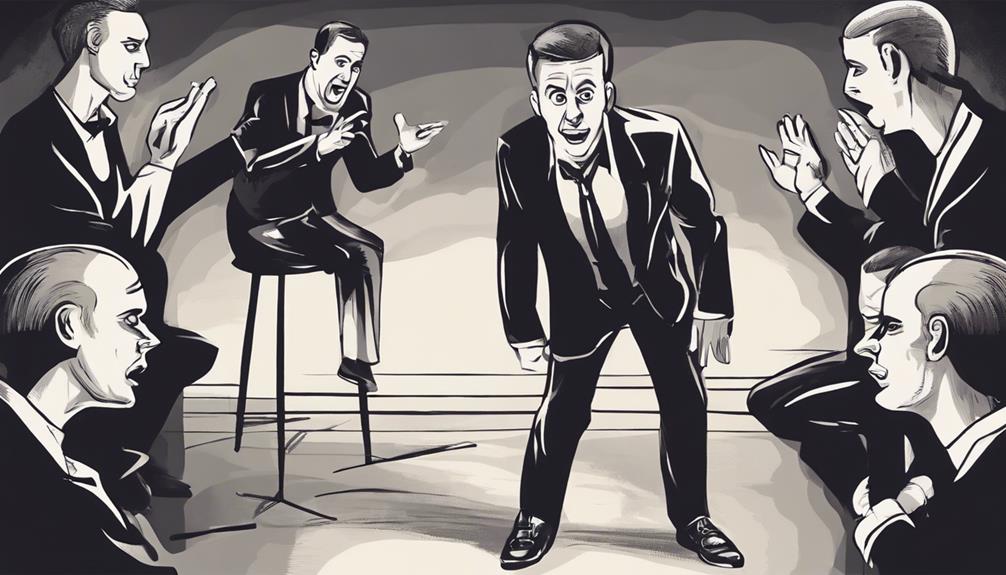Inside the realm of stage hypnosis lie hidden techniques that captivate audiences. The power of suggestion wields influence, while establishing quick rapport through nonverbal cues builds connections with participants. Misdirection tactics enhance performances, leading the audience's focus astray. Creating an illusion of control fosters engagement, showcasing surprising interactions. Leveraging psychological principles forms the foundation of compelling shows, tapping into subconscious influences. These techniques unravel the intrigue of stage hypnosis, offering insights into the artistry that mesmerizes crowds.
The Power of Suggestion

The power of suggestion plays a pivotal role in stage hypnosis, influencing participants to respond to cues and commands in a heightened state of suggestibility. Through subtle subconscious influence and skillful hypnotic performance, stage hypnotists are able to manipulate the minds of their volunteers, leading to mesmerizing displays of audience participation. By leveraging the suggestibility of the human mind, these performers can create illusions that captivate and entertain audiences while showcasing the depths of the subconscious.
Mind manipulation techniques are employed to establish a deep connection with participants, fostering trust and openness essential for the success of the performance. The hypnotist's ability to guide volunteers into a trance-like state where their subconscious minds are more receptive to suggestions is what sets the stage for the remarkable feats witnessed during a hypnotic show.
Audience participation is not only encouraged but integral to the overall experience, as the collective energy and engagement further enhance the hypnotic atmosphere, making each performance unique and unforgettable.
Establishing Rapport Quickly
Rapidly building a strong connection with volunteers is a fundamental skill for stage hypnotists to effectively engage and guide participants into a hypnotic state. Building trust is paramount in this process. To establish rapport quickly, stage hypnotists rely heavily on nonverbal communication cues. These cues include maintaining eye contact, mirroring the volunteers' body language, and using gestures that convey warmth and understanding.
Nonverbal communication plays a crucial role in creating a sense of comfort and familiarity between the hypnotist and the volunteers. By paying close attention to the subtle cues given off by the participants, such as their posture, facial expressions, and overall demeanor, the hypnotist can adapt their approach to better connect with each individual.
Furthermore, utilizing mirroring techniques, where the hypnotist subtly mimics the body language of the volunteers, can subconsciously foster a sense of connection and trust. This nonverbal synchronization helps create a harmonious atmosphere conducive to the hypnotic process.
Mastering these nonverbal communication techniques is key to swiftly establishing rapport and gaining the trust necessary for successful stage hypnosis performances.
Utilizing Misdirection Techniques

Employing strategic misdirection techniques enhances the mystique and effectiveness of stage hypnosis performances. Through distraction tactics and mind games, stage hypnotists keep the audience focused on one element while manipulating another. Distraction tactics involve creating a diversion to draw attention away from the actual technique being used. This can be achieved through verbal cues, sudden movements, or engaging the audience in interactive activities. By utilizing misdirection, the hypnotist can subtly guide the audience's focus and enhance the overall illusion of control.
Mind games play a crucial role in misdirection techniques. The hypnotist may use psychological tricks to influence the participant's thought patterns and behaviors without them realizing it. This can involve subtle language patterns, persuasive communication techniques, or playing on the participant's subconscious desires.
Creating the Illusion of Control
In stage hypnosis performances, one key aspect involves creating the illusion of control over the participants' actions and behaviors. Through skillful manipulation tactics, hypnotists make it appear as though they have complete authority over the volunteers on stage. This illusion is vital for the success of the performance art, as it enhances audience participation and engagement.
By fostering the belief that the hypnotist has the power to influence behaviors, the audience becomes more invested in the show, eagerly anticipating the unexpected and often entertaining outcomes.
Within this context, audience reactions play a crucial role. As the hypnotist guides the participants through various suggestions, the audience witnesses their responses, ranging from humorous antics to surprising behaviors. These reactions fuel the overall ambiance of the performance, creating a dynamic interaction between the hypnotist, volunteers, and spectators.
The hypnotist's ability to maintain the illusion of control while eliciting diverse audience responses showcases the intricacies of stage hypnosis as a captivating form of entertainment.
Leveraging Psychological Principles

Utilizing fundamental psychological principles forms the cornerstone of successful stage hypnosis performances. This guides the hypnotist in orchestrating captivating and engaging interactions with their volunteers. By tapping into subconscious influences and employing persuasive communication techniques, stage hypnotists can create a powerful connection with their participants.
Building trust is essential in this process. It allows volunteers to feel comfortable and open to suggestions. Manipulation tactics, when used ethically and responsibly, can aid in enhancing the overall experience for both the hypnotist and the volunteers.
Understanding how to subtly influence behavior and thoughts through psychological cues can lead to a more profound hypnotic state and a more entertaining performance.
Frequently Asked Questions
How Do Stage Hypnotists Choose Participants From the Audience?
When considering audience selection, stage hypnotists use various techniques to identify willing participants. Understanding participant reactions and navigating challenges such as skepticism and stage fright are crucial aspects in ensuring a successful and engaging hypnosis performance.
Can Anyone Be Hypnotized on Stage?
Hypnotizability spectrum varies among individuals, affecting their susceptibility on stage. Psychological preparation is crucial to enhance responsiveness. Ethical considerations dictate the need for informed consent and respect for participants' boundaries. Effective crowd control ensures a safe and engaging performance.
What Happens if a Participant Doesn't Follow the Hypnotist's Suggestions?
When a participant doesn't follow the hypnotist's suggestions, it may indicate resistance. The hypnotist can handle non-compliance with gentle redirection or alternative approaches. This can lead to varied consequences, affecting the flow of the performance and audience reactions.
Do Stage Hypnotists Use Pre-Planted Actors in Their Shows?
Stage hypnotists must uphold ethical boundaries by avoiding the use of pre-planted actors in their shows. Audience selection should involve a transparent consent process to ensure genuine participation and maintain the integrity of the performance.
Are There Any Risks or Dangers Associated With Stage Hypnosis?
When engaging in stage hypnosis, it's vital to consider ethical considerations and participant safety. Legal implications must also be understood to ensure compliance. Additionally, being cognizant of audience reactions is key to managing potential risks effectively.
Conclusion
In conclusion, stage hypnosis relies on the power of suggestion, establishing rapport quickly, utilizing misdirection techniques, creating the illusion of control, and leveraging psychological principles.
These hidden techniques work together to create a captivating and entertaining performance for audiences.
By understanding and mastering these techniques, stage hypnotists are able to create a memorable experience for their viewers.
